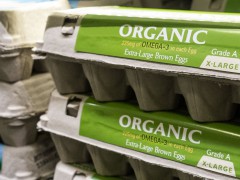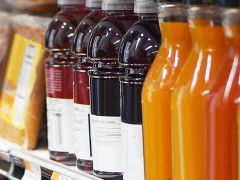— by Gabriella Agostinelli
Food manufacturers who seem to market foods to Celiac disease sufferers have reason to celebrate this month after the FDA has released a final rule for the use of “gluten-free” claims in food labeling. The autoimmune disease, which affects at least 1 out of every 133 Americans, causes the small intestine to become hypersensitive to gluten, interfering with the body’s absorption of nutrients and making digestion greatly painful and difficult. Now that the FDA has created a rule, American consumers can have greater confidence that foods labeled “gluten-free” are, in fact, just that (for the most part).

“This is like, entirely gluten. So, caution ‘n stuff.”
Under FDA’s new rule, food manufacturers may use the claim “gluten-free” unless the unavoidable presence of gluten in the food is less than 20 parts per million (ppm). According to the FDA, this is the lowest level that can be consistently detected in foods using valid scientific analytical tools.
In addition, the FDA will allow manufacturers to label a food “gluten-free” only if it does not contain any of the following:
a) a gluten-containing grain, such as wheat, rye, barley, or crossbreeds of these grains;
b) an ingredient derived from these grains and that has not been processed to remove gluten; or
c) an ingredient derived from these grains and that has been processed to remove gluten, if it results in the food containing 20 or more parts per million (ppm) gluten.
See 21 C.F.R. § 101.91. Foods such as bottled spring water, fruits and vegetables, and eggs that inherently do not contain gluten also can be labeled “gluten-free.” This is a good thing. USDA labeling regulations for example, don’t let producers brag about the lack of hormones in their chicken unless they also say that hormones shouldn’t be in the chicken to begin with. It is nice to see the FDA give all food producers a free hand to talk about this characteristic of their products, no strings attached.
Although it’s a certainty that not everyone will be happy with the gluten level established by the rule, any clarity is better than the myriad of public and third party guidelines that existed before. Prior to this, food manufacturers had an array of gluten levels to choose from. A 20 ppm standard will at least be consistent with the levels set by other countries and international bodies setting food safety standards.Private, third-party gluten-free certification require “gluten-free” products to contain less than 10 ppm (NFCA/GFCP, GFCO, QAI/NSF International) or less than 5 ppm of gluten (CSA Seal of Recognition, GFS Labs).
Most importantly, the level set by the new rule is consistent with earlier, though, non-binding FDA guidance. For food manufacturers who had adhered to the nominal 20 ppm standard, it’s business as usual in the post-“gluten free” world. For manufacturers who want to adhere to an even stricter standard, they still have the tighter tolerances of the third-party labelers to further differentiate their products to Celiac consumers.

















